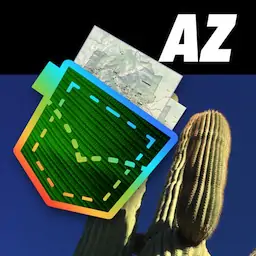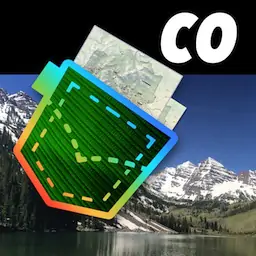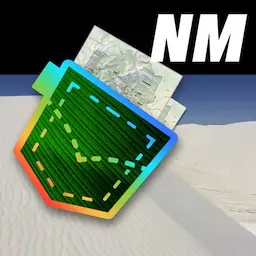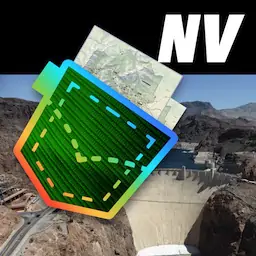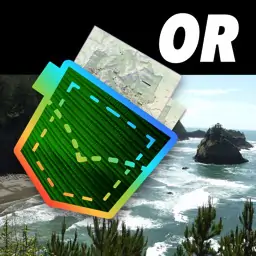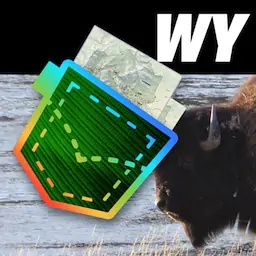IdahoNHT Auto Tour Guides |
The National Historic Trail route along the Snake River through Idaho. Published by the National Park Service (NPS).
featured in
covered parks
National Trails System
National Park Service
U.S. Department of the Interior
National Historic Trails
Auto Tour Route Interpretive Guide
Along the Snake River Plain Through
Idaho
“Three Island Crossing” by William
Henry Jackson
“Great Falls” on the Snake River. Courtesy of Library of Congress.
NATIONAL HISTORIC TRAILS
AUTO TOUR ROUTE INTERPRETIVE
GUIDE
The Tangle of Trails Through Idaho
Prepared by
National Park Service
National Trails System—Intermountain Region
324 South State Street, Suite 200
Salt Lake City, Utah 84111
Telephone: 801-741-1012
www.nps.gov/cali
www.nps.gov/oreg
www.nps.gov/poex
www.nps.gov/mopi
NATIONAL PARK SERVICE
DEPARTMENT OF THE INTERIOR
October 2008
Contents
Introduction• • • • • • • • • • • • • • • • • • • • • • • • • • • • • • • • 1
THE DESERT WEST• • • • • • • • • • • • • • • • • • • • • • • • • • 2
THE SNAKE COUNTRY • • • • • • • • • • • • • • • • • • • • • • • 4
FINDING THE WAY • • • • • • • • • • • • • • • • • • • • • • • • • • 7
WYOMING TO FORT HALL• • • • • • • • • • • • • • • • • • • • • 11
THE RAFT RIVER PARTING OF THE WAYS• • • • • • • • • • 20
ON TO OREGON• • • • • • • • • • • • • • • • • • • • • • • • • • • • 22
‘O FOR MORE PATIENCE’: A SNAKE RIVER SOJOURN • • 29
‘DEATH OR THE DIGGINS’• • • • • • • • • • • • • • • • • • • • • 32
‘OUTRAGES HAVE BEEN COMMITTED’• • • • • • • • • • • 35
YESTERDAY AND TODAY• • • • • • • • • • • • • • • • • • • • • 41
SITES AND POINTS OF INTEREST• • • • • • • • • • • • •
42
AUTO TOUR SEGMENT A: WYOMING TO OREGON ON THE
SNAKE RIVER ROUTE OF THE OREGON TRAIL
• • • • 45
AUTO TOUR SEGMENT B: THE SOUTH ALTERNATE
OREGON TRAIL ROUTE, GLENNS FERRY TO OREGON
STATE LINE • • • • • • • • • • • • • • • • • • • • • • • • • • • • • • 78
FOR MORE INFORMATION:
• • • • • • • • • • • • • • • • • 82
Credits:
• • • • • • • • • • • • • • • • • • • • • • • • • • • • • • 82
Auto Tour Route Interpretive Guide
Idaho
Introduction
M
any of the pioneer trails and other historic
routes that are important in our nation’s
past have been designated by Congress as National
Auto Tour Historic Trails. While most of the old roads and
routes still in existance are not open to motorized
Route
traffic, people can drive along modern highways
that closely parallel the original trails. Those
modern roads are designated as Auto Tour Routes, and they are
marked with highway signs and trail logos to help today’s travelers
follow the trails used by the pioneers who helped to open the
American West.
This interpretive publication guides visitors along the Auto Tour
Routes for the Oregon and California National Historic Trails
across Idaho. Site-by-site driving directions are included, and an
overview map is located inside the back cover. To make the tour
more meaningful, this guide also provides a historical overview of
the two trails, shares the thoughts and experiences of emigrants who
followed these routes, and discusses how the westward expansion
impacted native peoples of Idaho.
Individual Auto Tour Route interpretive guides such as this one are in
preparation for each state through which the trails pass. In addition,
individual National Park Service brochures for the Oregon and
California National Historic Trails are available at many trail-related
venues, and also can be requested from the National Trails System
administrative office at 324 South State Street, Suite 200, Salt Lake
City, Utah 84111. Each brochure includes a map of the entire trail
and an overview of trail history. Additional information about each
trail also can be found on individual trail web sites. Links are listed
on the “For More Information” page of this guide.
Auto Tour Route Interpretive Guide
Idaho
THE DESERT WEST
A
s covered-wagon emigrants crossed today’s Idaho, they found
the romance of the road wearing as thin as the soles of their trailtorn shoes.
The pioneers’ initial energy
and excitement curdled into
fatigue and crankiness after
three or more months on the
road. Nightly fireside dances
got left behind back down the
trail, next to Grandpa’s clock,
Mother’s good china, and
heaps of souring bacon. Highjinks and horse races grew
rare, quarrels more frequent.
Journal-keepers, when they
“Freighters Grub Pile,” by William
mustered the energy to write at all,
Henry Jackson. Courtesy of Library of
generally jotted terse complaints
Congress.
about fellow travelers, Indians, heat,
exhaustion, dust, mosquitoes, aches and pains, and the “stink” of the
never-ending sagebrush.
It seems the nearer we approach Oregon the worse roads we
have, and a worse more rough looking country.
—Amelia Hadley, 1851 Oregon emigration
Felt today like giving up in despair, the intolerable heat and dust,
together with fatigue makes me almost sick at heart.
—Esther Belle Hanna, 1852 California emigration
[Men] are by turns, or all together, cross, peevish, sullen,
boisterous, giddy, profane, dirty, vulgar, ragged, mustachioed,
bewhiskered, idle, petulant, quarrelsome, unfaithful, disobedient,
refractory, careless, contrary, stubborn, hungry and without the
fear of God and hardly of man before their eyes.
—Israel Shipman Pelton Lord, 1849 California gold rush
2
Auto Tour Route Interpretive Guide
Idaho
Most emigrants reached this part of the overland trail in late July or
August, when the heat of the day presses down like a heavy quilt,
burdening the body and muddying the mind. Some of the strongest
oxen, too, were weakening and failing, having faithfully pulled
heavy wagons nearly 1,300 miles over mountains and plains. But
even as energy and enthusiasm ebbed, travelers knew that they were
beginning the most difficult part of their overland journey. They were
entering the heart of the Desert West: a land of volcanic barrens,
sagebrush steppe, salt-crisped deserts, and mountain ranges like
rows of teeth. Idaho’s part of the Desert West is known as the Snake
Country.
Southern Route of the Oregon Trail near Murphy, Idaho.
3
Auto Tour Route Interpretive Guide
Idaho
THE SNAKE COUNTRY
T
he Oregon Trail, also
used in part by travelers
bound for California,
follows the sweep of the
Snake River Plain across
Idaho. Much of this plain is
irrigated farmland now, but
it was no bountiful prairie in
covered wagon days. Parts
are basalt-encrusted barrens
with sharp, broken rock
that chewed up hooves and
feet. Other parts are covered
The Snake River Plain (outlined in red)
with volcanic ash or ancient
provided a relatively flat surface for wagon
lake sediments, easily kicked
travel. Base map is courtesy of Idaho State
into the air by passing wheels
University Department of Geology.
and hooves. Instead of lush
grass for hungry livestock, this land then bristled with gray-green
sagebrush that snatched at wagon wheels and tore the legs of oxen.
The plain is stingy with water, too. It thirstily sucks up runoff, pulls
rivers underground into desert “sinks” (that’s how Idaho’s Big and
Little Lost Rivers became lost), and then spits the water directly into
the Snake River, miles away.
And that unfriendly river has cut itself deeply into the plain, where it
flows aloof and armored by high walls of black basalt. For miles along
the Snake River, thirsty people and livestock could only look down
from high on the rim rock to the taunting water hundreds of feet
below. The Snake was no tame workhorse either, no docile carrier of
people and freight. Today it has been gentled by irrigation and dams,
but 150 years ago this was a wild bronco of a stream, with rapids,
falls, and cascades that bucked off all manner of boats. Such was its
violence that French-Canadian trappers called it La maudite rivière
enragée—“the accursed mad river.”
4
Auto Tour Route Interpretive Guide
Idaho
This is one of the most singular rivers in the world being for miles
enclosed by a perpendicular ledge of rocks & the thirsty animals
are obliged to toil for miles together in the heat & dust with the
sound of water in their ears & neither man or beast able to get a
drop.
—Polly Coon, 1852 Oregon emigration
The Snake River (which emigrants also knew as Lewis’s Fork of the
Columbia River) takes its modern name from the so-called Snake
Indians who controlled that region. Snake was the common name
given by nineteenth century white Americans to the various Shoshone
groups, possibly because the sign language for Shoshone was a
snake-like motion of the hand. Many Shoshone groups depended
on Snake River salmon as a primary food source. (Buffalo, once
common on the Snake River
Plain, were rare there by the
1840s.) Emigrants following
the Oregon Trail sometimes
encountered Shoshone Indians
and their Paiute friends, the
Bannocks, fishing along the
river. Sick of a diet of bacon
and beans, travelers were happy
for a chance to trade for fresh
salmon. These encounters
typically were peaceful, with the
The Shoshone people viewed the
emigrants as a threat to their survival. emigrant “trade caravans” meeting
Courtesy of Library of Congress.
up with the Indian “food bazaars”
and everyone hoping to strike a
good deal. But while emigrants grudgingly admired the native Plains
horsemen they had met earlier along the trail, some scorned the
Snake River people—especially poorer groups without horses—and
tended to treat them harshly, sometimes brutally. For their own part,
the Shoshones and Bannocks were skilled nighttime raiders who
could make horses, mules, and oxen vanish from under the noses of
wagon-camp guards. Sometimes after a quiet night, a guard would be
discovered dead in the morning, his eyes open wide in surprise, his
chest pierced by silent arrows. By the 1850s, many emigrants regarded
5
Auto Tour Route Interpretive Guide
Idaho
the Snake Country as the most dangerous part of the overland trails.
The native people of the region viewed the emigrants as a threat to
their very survival.
I can hardly lay down to sleep without It seems as though The
Indians stood all around me ready to masacree me, shall be glad
to go.
—Amelia Hadley, 1851 Oregon emigration
But Indians were the least of the worries faced by the first covered
wagon pioneers who rolled into Idaho.
Towering basalt cliffs frequently kept thirsty emigrants and livestock from the life-saving
waters of the Snake River.
6
Auto Tour Route Interpretive Guide
Idaho
FINDING THE WAY
T
he 69 men, women, and children who joined the first emigrant
wagon train to set out across the Kansas prairie knew where they
were going: to California, some 2,000 miles away. And they knew how
they would get there: they would go west until they arrived. It was an
elegant plan; but the
devil, as they say, was
in the details.
In May 1841, no
wagon roads to
Oregon or California
yet existed. There were
only long-distance
Indian footpaths worn
deeper by fur trade
“Emigrant Party on the Road to California.” Courtesy of
traffic following the
Beniecke Rare Book & Manuscript Collection, Yale University.
Platte River toward the
Rocky Mountains. No
member of the emigrant
party knew the route, and no useful government map or published
guidebook was available to advise tenderfoot travelers along the way.
On top of all that, these American emigrants would be trespassers in
much of the country to be crossed and illegal squatters on the land
they planned to settle, for nothing west of the Continental Divide was
American soil. Mexico claimed the Southwest, the U.S. and Great
Britain disputed the Oregon Country, and American Indian peoples—
nations, really, with distinctive languages and cultures—occupied and
controlled the region. Yet the members of the “Western Emigration
Society,” as these pioneers called themselves, were determined to go
overland to California and confident they would get there.
No one of the party knew anything about mountaineering and
scarcely anyone had ever been into the Indian Territory, yet a
large majority felt that we were fully competent to go anywhere
no matter what the difficulties might be or how numerous and
warlike the Indians.
—John Bidwell, 1841 California emigration
7
Auto Tour Route Interpretive Guide
Idaho
What these greenhorns lacked in good sense they made up in
good fortune. Near the start of their trip, just a few days west of
Independence, Missouri, they met up with Thomas “Broken Hand”
Fitzpatrick. The famed mountain man was guiding a company of
missionaries bound for the Pacific Northwest, but he agreed to take
the emigrants along through the Rocky Mountains. “And it was well
that [he] did,” recalled pioneer John Bidwell years later, “for otherwise
probably not one of us would ever
have reached California, because
of our inexperience.”
Fitzpatrick led the combined
company up Nebraska’s Platte
River, through the Rockies and
across the Continental Divide
at South Pass, Wyoming, and
into today’s Idaho southeast of
present-day Montpelier. The
party then followed the flow
Relatively flat land and adequate
of the Bear River northwestward
water made for a good wagon road in
the Bear River valley.
past Soda Springs to Sheep Rock,
where the river curls around the
north end of the Wasatch Mountains and turns back to the south.
There, Fitzpatrick’s party prepared to split up: the missionaries and
their guide would continue to the Northwest by way of Fort Hall, a
Hudson’s Bay Company fur
trade post, and the settlers
would turn, pilotless, toward
California.
“Westward America,” by William
Henry Jackson, near Split Rock,
Wyoming.
8
Auto Tour Route Interpretive Guide
Idaho
…there was no road for us to follow, nothing was known of the
country, and we had nothing to guide us, and so [Fitzpatrick]
advised us to give up the California project. He thought it was
doubtful if we ever got there; we might get caught in the snow of the
mountains and perish there, and he considered it very hazardous to
attempt it.
—Josiah Belden, 1841 California emigration
Fitzpatrick believed the inexperienced emigrants were foolish to
blunder into the unmapped interior on their own. He persuaded
about half of them to give up their California dreams and follow
the Snake and Columbia Rivers to Oregon, instead. The other 34
determined emigrants (including a woman and infant) spurned the
mountain man’s sensible advice and turned their oxen south down
the Bear River toward the Great Salt Lake. The Bidwell-Bartleson
Party, as that group is now known, took the first wagons into
northern Utah, but the trial-and-error trail they blazed down the Bear
River, around the Great Salt Lake, and into Nevada was so difficult
that few would attempt to follow in their track. Later Californiabound travelers developed a network of better routes through
southeastern Idaho.
We were now thrown entirely upon our own resources. All the
country beyond was to us a veritable terra incognita, and we
only knew that California lay to the west.
—John Bidwell, 1841 California emigration
But the other Western Emigration Society pioneers left their wagons
at Fort Hall and continued with pack animals along the Snake River,
as Fitzpatrick had advised. Their faint trace through the sagebrush
would become the main emigrant route to Oregon, leading thousands
of people west over the next 30 years.
As more wagons trickled and then flooded across the West, the track
along the Snake River evolved into a wagon trail and finally a network
of well-beaten roads that snaked around mountains and marshes,
kept to high ground, and generally went wherever water and grass
could be found. These roads were not rustic wagon-width versions
of today’s paved highways, direct and efficient, with two lanes for
9
Auto Tour Route Interpretive Guide
Idaho
traffic to follow in orderly single file. Rather, they were evolving,
bustling, multi-lane, winding, spreading-out and drawing-in, freefor-all travel corridors with no rules of the road, constrained in their
wanderings and widths only by geography and the locations of grass
and water. They went wherever somebody thought he could drive a
wagon, and they were developed by repeated use, rarely by engineers
or work crews. Over the years, travelers developed a tangle of wagon
trails through the basin and range country of southeastern Idaho and
across the Snake River Plain as they sought out shorter, easier, or safer
ways west.
The Snake River route formed the spine of the combined Oregon and
California Trails. To reach the river, westbound wagons first had to
thread through the mountains of southeastern Idaho.
The basic course of the road to Oregon followed the Platte River to the Sweetwater, to
the Bear, to the Snake, and ultimately, to the Columbia.
10
Auto Tour Route Interpretive Guide
Idaho
WYOMING TO FORT HALL
T
he combined Oregon and California Trails enter eastern Idaho
from Wyoming through the natural mountain-edged corridor
of the Bear River Valley. That valley was glorious: nearly 80 miles of
abundant water, cool air, spectacular scenery, and plentiful timber,
grass, fish, and wildfowl. Its beauty and bounty, coming on the
heels of a hard, dry haul across southwestern Wyoming, raised the
emigrants’ spirits and inspired some writers to poetry.
Love never dwelt in a much more charming valley. Here one
might live secluded. From side to side his eyes might rest on
mountain tops and no gate left open, except where the babbling
waters play.
—John Edwin Banks, 1849 California gold rush
The main trail crosses the
Thomas Fork, stays north of the
Bear River, and climbs directly
into the Sheep Creek Hills.
That climb was hard but the
descent was far worse, forcing
emigrants to lock their wagon
wheels for a long, frightening
skid down Big Hill to the valley
floor. Furrows scoured into the
earth by unyielding iron-rimmed
wheels are visible today from U.S.
The descent from Big Hill followed
Highway 30. From there the main
the wash just to the left of center in
trail went along the north side of the this image. Courtesy of Wisconsin
Historical Society.
Bear River Valley through today’s
Montpelier and on to Soda Springs,
one of the natural wonders of the Oregon and California Trails. The
Soda Springs are a complex of gaseous mud-pots, fountains, and
naturally carbonated pools, which according to Shoshone tradition
are healing waters.
11
Auto Tour Route Interpretive Guide
Idaho
My spirits were low till I heard, “There is the Soda Springs.” This
acted like electricity....They are wonderful and deserve a place in
the wonders of the earth.
—John Edwin Banks, 1849 California gold rush
The whole valley…is the most interesting spot of earth that I
ever beheld. Here is a grand field for the geologist, mineralogist,
naturalist, & any other kind of ‘ist’ that you can conceive.
—Dr. Wakeman Bryarly, 1849 California gold rush
The most famous of these
features was Steamboat Spring,
which huffed and whistled like
a steamboat as pressurized
gas and water erupted from
a low travertine cone. Sarah
White Smith, traveling with a
missionary company in 1838,
watched a prankster try to stop
Steamboat Spring from spouting
by removing his trousers
and sitting on the cone’s six-inch
opening.
“Steam Boat Springs” by artist James
F. Wilkins, 1849, at Soda Springs,
Idaho. Courtesy of the Wisconsin
Historical Society.
“He did not have to wait very long
for the flow,” she recounted. “It came gradually at first, but increased
in force every moment. Doyle soon began bobbing up and down at
a fearful rate. At this stage of the fun several of the boys took hold of
Doyle and tried to hold him on the crevice, but in this they failed, for
the more weight they added to Doyle the more power the spring seemed
to have, and Doyle kept bobbing up and down like a cork.” The man
finally pleaded to be released, exclaiming, “I am now pounded into a
beefsteak!”
Steamboat Spring is submerged by Alexander Reservoir now, but
a churning on the lake surface reveals its location. Dozens of other
springs have been altered or destroyed by years of development,
which began in 1863 when a settlement and an army camp were
12
Auto Tour Route Interpretive Guide
Idaho
established in the area. A few, including Hooper Springs, are still local
attractions. Emigrants loved to sample their water, using flavorings
to create soda beverages, mixing it into bread dough for leavening, or
just drinking it like beer and imagining themselves growing tipsy.
The Sody Spring is quite a curiosity thare is a great many of them
Just boiling rite up out of the ground take alitle sugar and desolve
it in alitle water and then dip up acup full and drink it before it
looses it gass it is frustrate [first rate] I drank ahol of galon of it.
—William J. Scott, 1846 Oregon emigration
But in the Bear River Valley, emigrants began encountering another
natural wonder that was not so much fun: crawling armies of large,
leggy “crickets” that devoured anything in their path.
The “crickets” are really a type of katydid—not a true cricket, a
locust, or a grasshopper—that feeds on sagebrush and other plants.
Periodically their population booms and they swarm by the millions,
as many as 100 per square
yard, across the Desert West.
They will gobble up gardens
and field crops, munch on
clothing, quilts, and linens,
and even cannibalize their
own kind. They earned their
popular name, Mormon cricket,
when they attacked settler’s
crops around Salt Lake City in
1848. Native peoples used the
insects to make protein-rich
Mormon cricket. Courtesy of Idaho
soups and pemmican “bread,” but
Photo
most emigrants regarded Mormon
crickets as unappetizing.
The ground, for a strip of about four miles, was covered with
black crickets of a large size. I saw some that were about three
inches in length…. Our teams made great havoc among them; so
numerous were they that we crushed them at every step.
—Joel Palmer, 1846 Oregon emigration
13
Auto Tour Route Interpretive Guide
Idaho
Wingless, dumpy, black, swollen-headed, with bulging eyes
in cases like goggles, mounted upon legs of steel wire and
clock-spring, and with a general appearance that justified the
Mormons in comparing him to a cross of the spider on the
buffalo, the Deseret cricket comes down from the mountains at a
certain season of the year, in voracious and desolating myriads.
—Thomas Leiper Kane, in “The Mormons, a discourse
delivered before the Historical Society of Pennsylvania,
March 26, 1850”
A few miles west of Soda
Springs, the Bear River hairpins
around Sheep Rock and flows
lazily south toward the Great
Salt Lake. Sheep Rock, named
for the bighorn sheep that
passing emigrants sometimes
saw there, is where the 1841
Western Emigration Society
split up, with Fitzpatrick’s
company going on to Fort Hall
Sheep Rock, called Soda Point today,
and the Bidwell-Bartleson Party
is the northern end of the Wasatch
continuing down the river toward
Mountains. Courtesy of Library of
Utah. In 1849 a third alternate, the
Congress.
Hudspeth Cutoff, was blazed as
a shortcut to California. It angled
directly southwest away from the Bear River at Sheep Rock toward
the northeast corner of present-day Nevada, and soon became
the preferred route of the 1849 gold rushers and later emigrants to
California. Some Oregon traffic, as well as California-bound travelers
hoping to resupply, continued northwest along Fitzpatrick’s route
toward the Snake River and Fort Hall.
Good bye to Bear River. In one mile farther we reached the
junction of the Ft. Hall and Headspeth’s cut off roads, and after
some debate and a vote it was decided to go by Ft. Hall, the
minority grumbling greatly. The Mountaineers had invariably
advised us to take this rout.
—Byron N. McKinstry, 1850 California emigration
14
Auto Tour Route Interpretive Guide
Idaho
As the trail crosses today’s Fort Hall Indian Reservation and
approaches the site of the old Fort Hall trading post, the Lander
Cutoff merges from the east. This cutoff, developed in 1857-59 by
government engineer Frederick Lander, was the only federally funded
road ever constructed for the overland emigration. Lander’s road
went directly from the Ninth Crossing of the Sweetwater River, near
South Pass, Wyoming, to Fort Hall, thus bypassing the original trail’s
long meander southwest through Fort Bridger. But Fort Hall never
served the emigrants who arrived by the Lander Cutoff. By the time
the new road opened to traffic, the old fur-trade depot was closed
and abandoned.
Fort Hall, built in 1834 by New England businessman Nathaniel
Wyeth, was the first permanent American post in the entire Oregon
Country. Hardball business tactics by rival Hudson’s Bay Company
soon drove Wyeth into debt and forced him to sell his enterprise to
the British-owned corporation. As the profitable beaver-pelt trade
collapsed in the early 1840s, the Hudson’s Bay Company might
“Old Fort Hall Trading Post on the Snake River,” by William Henry
Jackson
15
Auto Tour Route Interpretive Guide
Idaho
have closed Fort Hall for good—but former trappers like Thomas
Fitzpatrick found work as trail guides and began bringing new
customers to the post. The developing Oregon Trail helped keep Fort
Hall in business for another 15 years.
Fort Hall was the last trading post for many miles, and as Californiabound Margaret Frink wearily observed in 1850, from there “the
worst part of the road is yet to be passed over.” It was a place where
emigrants could re-supply, repair wagons and equipment, exchange
livestock, and steel themselves for the hardest leg of their journey.
Even the exceptionally fierce clouds of mosquitoes that greeted
arrivals to Fort Hall did not discourage business. Many emigrant
parties stayed for several days, camping among the notoriously buggy,
boggy river bottoms around the post.
We camped four miles from the fort [Hall] amonst a million
of mosquitos they would not let you rest a moment and after
swallowing a cup of tea and about fifty of them with it I bundled
up head and ears and let them sing me to sleep.
—Joseph Hackney, 1849 California gold rush
Mosquitos were as thick as flakes in a snowstorm. The poor
horses whinnied all night, from their bites, and in the morning
blood was streaming down their sides.
—Margaret Frink, Fort Hall, 1850 California emigration
I have been much in musquitoe country, but confess I never
before saw them in their glory. They were so thick you could
reach out & get your handfull.
—Dr. Wakeman Bryarly, 1849 California gold rush
Ironically, the very success of the emigration helped put an end to
the fort, for the swelling tide of wagon traffic through the Snake
Country ignited Shoshone and Bannock resistance. Conflict in the
region helped persuade the Hudson’s Bay Company to close its Snake
River posts in 1855-56. Floods gradually washed away the fort’s
adobe buildings, but emigrants continued using the site for camping
and some independent traders operated there. Today, Shoshone and
Bannock guides lead travelers to the site of the old post, where they
16
Auto Tour Route Interpretive Guide
Idaho
can enjoy an authentic trail experience: the mosquitoes there are as
welcoming as ever!
Starting in 1852, travelers to Oregon could cross to the north side of
the Snake River near Fort Hall and take Jeffrey’s Cutoff, later called
the Goodale Cutoff, along the upper edge of the Snake River Plain.
This 230-mile alternate goes generally northwestward from the fort
toward Big Southern Butte, a notable landmark on the plain. The
Goodale Cutoff then turns west and crosses the north end of today’s
Craters of the Moon National Monument. Trail remnants all along
this route are still visible. They rejoin the primary route of the Oregon
Trail east of Boise. It is a sun-baked, boot-shredding, wagon-jolting
route that alternately crosses rugged lava flows, dense stands of
sagebrush, and sand barrens with no feed for the livestock. Despite its
challenges, the Goodale Cutoff became a popular option for Oregonbound emigrants in 1862 when fights between emigrants and Indians
along the Snake River road were making national news.
The roadbed is only known by the rocks and lava being crushed
by the many teams passing over it...all day long we slowly creep
along lacerating our horses feet and threatening wheels, axles,
or some portion of our outfit. All along were pieces of broken
wagons which had met with such accidents.
—Harriet A. Loughary on
Goodale’s Cutoff, 1864
Oregon emigration
Most wagon trains departing
Fort Hall, though, turned west
to follow the combined Oregon/
California Trail down the south
rim of the Snake River, which
lay snug in its deep bed of
basalt. The main trail crawled
southwestward over increasingly
rough terrain and, in places, along
dangerously narrow riverside bluffs.
One or two days’ travel—about
25 miles—over that road brought
Dams on the Snake River have
reduced the roaring waterflow,
revealing the deep basalt walls that
determine its course. Courtesy of Idaho
State University Department of Geology.
17
Auto Tour Route Interpretive Guide
Idaho
travelers to the American Falls, where the river dropped 50 feet in
a series of roaring whitewater cascades. Emigrant journals often
remarked on the spot’s natural beauty and sometimes mentioned
trading with Indians for fish at this location. The tranquility of the
place belies the violence that occurred nearby one hot August evening
in 1859.
The Miltimore Party, a wagon train of 19 men, women, and children
on their way to California, had strung out along the trail as they
approached their evening camp above American Falls. Several wellarmed white men poorly disguised as Indians—having dark skin
but light brown hair and beards and speaking standard English—
suddenly approached on horseback and commandeered two lagging
wagons at the rear of the train. At their signal, 15 to 20 more men
jumped the rear wagons and began shooting, sparing no one. The
forward wagons quickly were drawn into the attack, as well. Some
emigrants escaped into thick willows along the river, where they
listened, terrified, to the “whooping and hollering of the Indians”
through the night.
An army expedition from Fort Walla Walla, encamped on the Raft
River, came across 11 survivors afoot on the trail three days later.
Soldiers looking for more survivors found a horrific scene of brutality
at the attack site. They buried
eight victims in a common
grave that now rests beneath
American Falls Reservoir.
Indians, probably Shoshones
and Bannocks, took part in the
killings, but according to some
of the survivors, white “land
pirates” in search of plunder
master-minded the ambush.
Volcanic basalt along the south side of
the Snake River Canyon at Massacre
Rocks provided hiding places where
unsuspecting wagon trains could be
attacked.
18
Three years later and about
10 miles west of the Miltimore
killing grounds, in an area now
called Massacre Rocks, about 150
Auto Tour Route Interpretive Guide
Idaho
fighters under the Northwestern Shoshone War Chief Pocatello
engaged several more wagon companies in retaliation for earlier
unprovoked attacks by emigrants on his own people. Again, some
survivors reported white renegades among the attackers. Ten
emigrants and eight Indian fighters died in those skirmishes of August
9-10, 1862. Pocatello’s Shoshone and Bannock warriors launched
several more strikes that season along the Oregon and California
Trails in Idaho, hoping to halt emigrant trespass there. Within a year,
his efforts would pull disaster down on his people.
“Pilgrims on the Plains,” by Theo R. Davis. During the 1840s and 50s, tens of
thousands of emigrants poured across Bannock and Shoshone homelands. Courtesy
of Library of Congress.
19
Auto Tour Route Interpretive Guide
Idaho
THE RAFT RIVER PARTING OF THE WAYS
N
ews and wild rumors of Indian attacks through the 1850s
and early ’60s flashed up and down the trail and appeared in
newspapers throughout the country, fueling public demand for
military protection. Meanwhile, many emigrants already on the
road weighed the risks along
the Oregon and California
routes ahead. Some 15 miles
west of Massacre Rocks, at
the Raft River Parting of the
Ways, travelers would get
another chan


